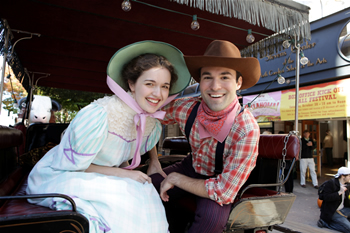The long annual drought of musical performances brought on by “holiday” related activities (that should cover everybody!) finally came to an end in this new year on January 8 at the North Carolina Museum of Art. The Raleigh Chamber Music Guild continued its collaboration with our state’s art museum as they presented another concert in the Sights and Sounds on Sundays series. (Hmm – interesting first and last letter alliteration….) Conjuring up images of the other-worldly northern lights by virtue of its name, Aurora Musicalis is a piano trio that evoked the musical equivalent of awe and surprise in a wonderfully varied and illuminating program. The group consists of violinist Brian Reagin, Concertmaster of the North Carolina Symphony (NCS), Elizabeth Beilman, Assistant Principal Cellist of the NCS, and pianist Kari Miller, a name new to me but a brilliant player that I look forward to hearing again.
The visual arts and music have a symbiotic relationship that the museum and this series have good intentions of exploring but in the past had not gone past the evocative name and the urging of people to come out early and view the current exhibits. That changed in this concert as Beilman took on the additional role of curator and art historian. She read some notes relating a specific painting to the work about to be performed (this could have been included as program notes), and a slide of this painting was displayed and remained throughout the playing of the composition. I found several of the connections rather tenuous, but such is the nature of art.
The afternoon’s program began with one of the many trios written by Haydn in yet another genre that was practically created by the incredibly prolific composer. I find it quite astounding how the very first impression is all it sometimes takes to gather the full impact of a musical ensemble. The opening chord and the few measures following was all it took to realize that we were in the presence of a collection of musicians who were much more than their individual prodigious talents. Miller brought out some of the most beautiful tone that I have ever heard from a piano, while Reagin was careful to remain a team player and not overpower the others when his part put him in the background. It was a real treat to hear a player like cellist Beilman emerge from the masses of the string section and experience her own voice. Despite the cello’s role as a predominantly supporting player in Haydn’s trios, she gave the trio a solid foundation and displayed a warm yet penetrating tone that gave an extra ping to the more peppy sections.
There was no more hiding for the cello in the second work as pianist Miller got a breather while Reagin and Beilman played Deux Choros for violin and cello by Heitor Villa-Lobos. Having made a living as cellist in the cafes of his native Brazil, Villa-Lobos has contributed a great deal to the cello repertoire, although much of it still remains seldom played. These pieces pull out every cellistic device: double and triple stops, unusual harmonics, frantic string crossings, and a rhythmic ostinato that clearly mimics the energy of the indigenous dance rhythms of Brazil. The violin and cello are constantly on a dangerous tightrope of cross-rhythms that at times sounded like they were falling off. It was in fact a tight but abandoned performance that gave a wonderful impression of late night cafes and hot nights in Rio.
It is one of the great joys of music that no matter how much you think you may know or have heard, there seem always to be new discoveries awaiting you. You then wonder how such a superb work stays under the radar screen while others are repeated like a mantra. The Trio in F minor by Antonín Dvorák is such a composition. His deservedly well-known and loved “Dumky” trio gets the spotlight as far as the four piano trios written by this Czech master, but this f minor trio struck me like a lightning bolt.
How could something as breathtakingly beautiful as this have eluded me after dozens of piano trio concerts? No matter – it is a found jewel. This is a wonderfully crafted work that straddles Dvorák’s folk influences with the traditional Classic/Romantic stylings and melds them into an unforgettable listening experience. This threesome milked all of the lushness and emotion with a sensitivity that melted most of us. As if this wasn’t enough, they returned to play an encore of the ultimate tear jerker: a Fritz and Hugo Kreisler arrangement of “Danny Boy.”











